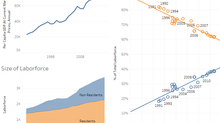Singapore in Numbers - Where Residents Live
Most countries typically publish summary metrics about the country annually; such as GDP, employment, population numbers etc. Once every 5 years of so, the Singapore Population Census collects and public more than their usual share of metrics; which allows us to take a more detailed glimpse into Singapore. In this segment we will be exploring the geographic distribution of residents in Singapore in 2020. FYT had did a similar analysis using data from the 2015 population census data; it would be interesting to see how things have changed over the last 5 years.
Did you know that...
The number of residents in Singapore didn't change much, there were 3.9M in the 2015 census, the 2020 census reported slightly above 4M residents
Residents grew markedly older. 12% of residents were aged above 65 in 2015, it has grown to 15% in the 2020 census

In traditionally older housing estates in the south (Outram, Bukit Merah and Queenstown), 18-20% of residents were aged above 65 in 2015. This number grew to 22% with significantly lower proportion of residents in younger age brackets.
As these towns aged physically, we can expect to see similar trends among the residents there as well; and the estates will have to adapt accordingly (more eldercare and less childcare facilities, more geriatric related health care services)
Families with children (aged 14 and below) make up about 15% of residents
Sembawang and Woodlands appear to have a higher proportion of teenagers; while families in Sengkang and Punggol have a higher proportion of younger children (aged below 5).
This could significant impact the mix of services provided in these planning areas (more infant/childcare in Punggol and Sengkang, and more student care in Woodlands and Sembawang)

The Chinese make up the majority race in Singapore (74%) followed by Malays (14%), Indian (9%) and Others (3%). But the racial distribution varies significantly across Singapore
Despite the ethnic integration policies which specifies the number of public housing units for the Chinese and other minority races, many subzones are more than 85% Chinese; such as Hougang, Ang Mo Kio, Bishan, Outram & Serangoon areas.
Malays make up only 14% of residents; but have at least 10% higher representation in the north (Woodlands, Sembawang), the east (Tampines and Pasir Ris) and pockets in the Bukit Batok and Choa Chu Kang areas
Indians are quite evenly distributed across the island in similar proportion as the national average, except for Tanjong Rhu where 31% are Indian though absolute numbers are small.
Others is a catch all category for any race that that is no Chinese, Indian or Malay. Data suggests that they have significantly higher representation in the downtown, Tanglin, Newton. They make up 36% residents on Sentosa Island
Check out our interactive dashboard and see what is happening in your neck of the woods.

























Comentarios